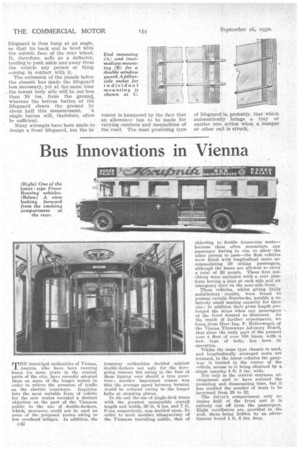Bus Innovations in Vienna
Page 64

If you've noticed an error in this article please click here to report it so we can fix it.
THE municipal authorities of Vienna, Austria, who have been running buses for some years in the central parts of the city, have recently adopted them on some of the longer routes in order to relieve the pressure of traffic on the electric tramways. Inquiries Into the most suitable form of vehicle for the new routes revealed a distinct objection On the part of the Viennese public to the use of double-deckers, which, moreover, could not be used on some of the proposed routes owing to low overhead bridges. In addition, the
tramway authorities decided agtinst double-deckers not only for the foregoing reasons but owing to the fear of them tipping over should a tyre puncture; another important reason was that the average speed between termini would be reduced owing to the longer halts at stopping places.
In the end the use of single-deck buses with the greatest permissible over4l length and width, 30 ft. 6 ins. and 7 ft. 6 ins, respectively, was decided upon. In order to meet another idiosyncrasy of the Viennese travelling public, that of objecting to double transverse seats— because these often necessitate one . passenger having to rise to allow the other person to pass—the first vehicles were fitted with longitudinal seats accommodating 29 sitting passengers, although the buses are allowed to carry a total of 50 people. These first machines were equipned .with a rear platform having a door at each side and an emergency door on the near-side front. These vehicles, whilst giving fairly satisfactory results, were found to possess certain drawbacks, notably a relatively small seating capacity for their size; in addition their great length prolonged the stops when any passengers at the front wanted to dismount. As the result of further experiments, we learn from Herr Ing. F. Hollerwoger, of the Vienna Tramways Advisory Board, that since the early part of the present year a fleet of over 100 huses, with a new type of body, has been in operation.
Whilst the same type chassis is used, and longitudinally arranged seats are retained, in the latest vehicles the gangway is located in the centre of the vehicle, access to it being obtained by a single opening 4 ft. 5 ins. wide.
Not only is the central entrance arrangement said to have reduced the mounting and dismounting time, but it has enabled the number of seats to be
increased from 29 to 32. • The driver's compartment only occupies half of the front and it is entirely cut off from the passengers. Eight ventilators are provided in the roof, these being hidden by an advertisment board 1 ft. 8 ins. deep.












































































































